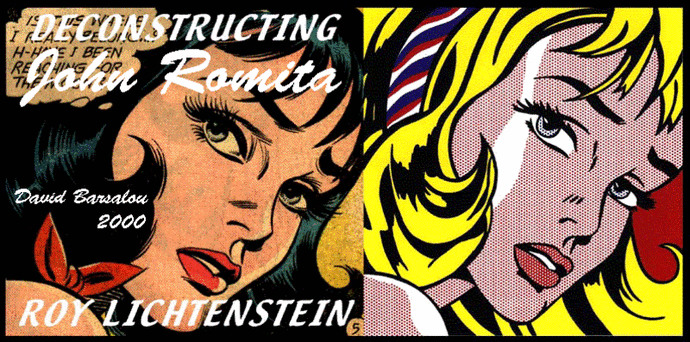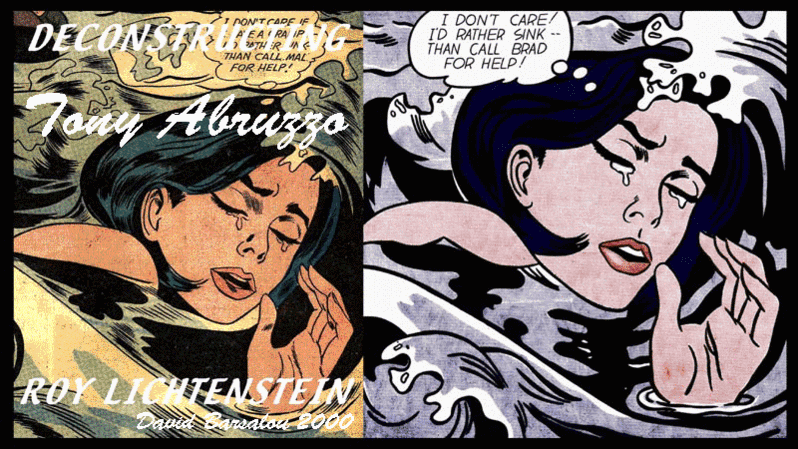
Sooooooo, I knew Lichtenstein had made his own adapted versions of images from Ads in the backs of magazines and from pulp comics,...I just didn't realize how MUCH of this he did. Now I know he did a lot of his own work as well, I was just a bit surprised when I came across this gem of a source comparing the original works from the artists who originated the images. They both have their place in the vast and subjective world of art so I don't feel the need to denounce his work. It's funny how it works though, because I would argue that the average non-art-obsessed viewer would never know anything other than his most famous Pop Art images and attribute full credit to him. I guess that's part of the darkness that goes along with Pop Art. Warhol understood this and exploited it to the hilt, and spoke about the dark humor that is the underbelly of much pop art. It seems that Lichtenstein may have understood this, but was not as vocal, or perhaps quoted much less in stating it outright.
The part of Lichtenstein's work that I think is the dark genius that I never hear spoken or written about is the scaled humor or perspective that must have thrown the fine art community for a loop. Since this brand of Pop Art was new to gallery goers I would imagine that the large dots he used were a bit confusing. I am not claiming to be the expert on this issue, I'm merely writing about it because I actually think this is of huge importance, but I have never heard anyone talk, or write about it. So, the exaggerated, organized dots....Much like pixels in our digital media today, old color printing for comics, newspapers and some magazines was done in several ways, one of them employing the method known as Ben-Day dots. ( https://en.wikipedia.org/wiki/Ben-Day_dots ) These strategically aligned and properly spaced dots, from a distance create the illusion of color and value, as the eye reads them blended together. When these large paintings were viewed in galleries, these scaled versions of the previously small images look a bit dazzling, and a bit confusing. As some of my students have said,'"Why does she have all of those red dots on her face? Does she have the measles? Or chicken pox?". As humorous as it is to hear children say this, I imagine adults seeing these in galleries and thinking the same thing...only not vocalizing it for fear of cultural rejection in the art world. Now perhaps there were some that got it, I can see that for sure...but I can also see in my mind's eye, people having a focused, thoughtful look on their face, perhaps fingers on their chin...stroking their goatee, nodding gently...
Alright, alright, it probably wasn't as stereotyped as this,...but you get what I am saying. ANYWAY...the coolest part is when you go to the other side of the gallery and look back, there it is! The same magic of the blended dots of color has appropriated itself on a larger scale and now you see the implied color! Like a large scale version of the distance from one's eyes to the comics in hand is now the gallery viewer on on the far side of the gallery enjoying the painting with it's illusion of solid color. Funny thing is, the large style stuck so well, that the exaggerated version of these organized dots (and the graphic black lines and satirical pulp humor) became the iconic style for Lichtenstein....
I just can't help wondering why the dots in context of a larger gallery is never talked about. Or why the original versions of the artwork from which his are "appropriated" are rarely mentioned. I am guessing it's partly because he was spoofing a generic version of American Pop Culture. Bummer for the original artists though right? Perhaps one step away from a super big break. I Would love to hear some more revealing conversations about his work instead of what seems to be the same glossy regurgitated versions of conversations, like ghosts repeating important lines in text books, creating a manufactured sales pitch for his cultural significance. Oh man, ok...So, I didn't plan on sounding that dark, but it just came out. oh well...And the funny thing is, amidst all this, I do like a bunch of his work. Hence the "Mixed Feelings" in the title.
Either way, Lichtenstein is definitely a landmark on the timeline of the history of art movements. And quite the status symbol as well. ($42,642,500 record price at Christie's auction for painting "Ohhh, Alright")
http://www.christies.com/features/roy-lichtenstein-ohhh-alright-1139-3.aspx
images from http://davidbarsalou.homestead.com/LICHTENSTEINPROJECT.html


 RSS Feed
RSS Feed
